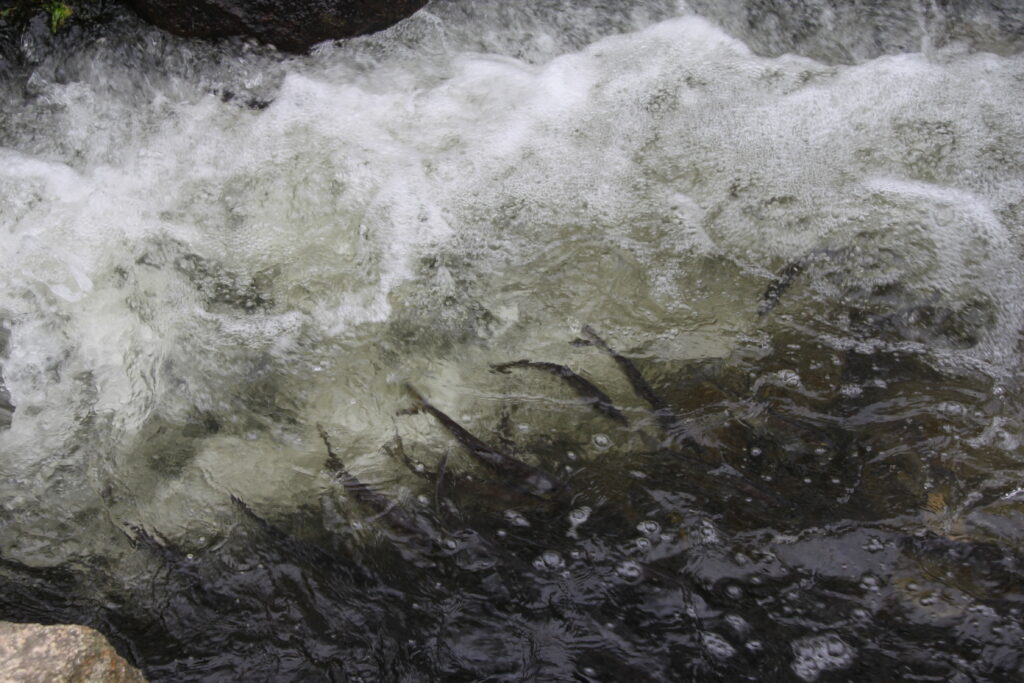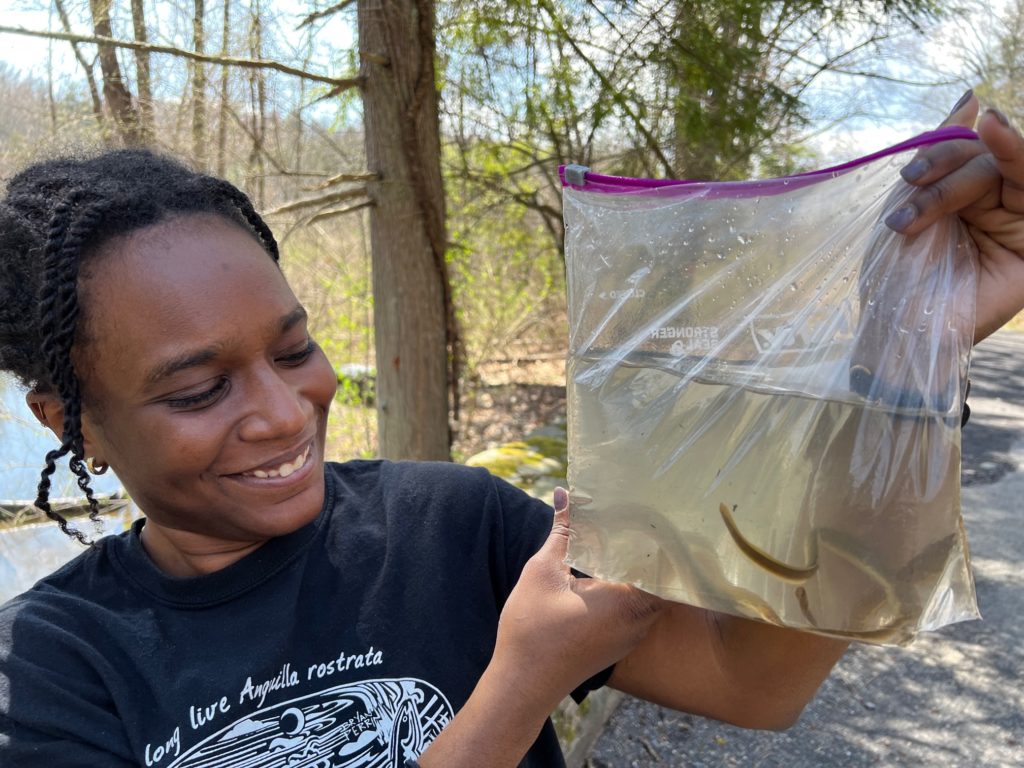By Devon Case
In the diverse aquatic tapestry of the Northeastern U.S., diadromous fish – species that migrate between freshwater and saltwater – play a crucial role in maintaining ecological balance. However, climate change is having a significant impact on these important species, leading to declines in their populations.
Connecting Ecosystems: The Role of Sea-Run Fish
Just 1% of fish species world-wide fall into the diadromous – or sea-run fish – category, which includes both anadromous and catadromous fish. Anadromous fish, such as river herring and American Shad, are born in rivers and migrate to the sea to mature, returning to their freshwater homes to spawn. Their counterpart, catadromous fish such as the American eel, boast the opposite and less common life cycle, spending most of their life in freshwater and returning to saltwater to lay their eggs.

These migratory patterns are essential for the transport of nutrients across marine, freshwater, and estuarine environments. The American eel, for instance, transfers nutrients between freshwater and marine ecosystems as both predator and prey. As a predator, it feeds on fish, invertebrates, and insects, while as prey, it provides a food source for other predators such as ospreys and eagles. These nutrient transfers play a crucial role in maintaining the health and productivity of interconnected aquatic ecosystems.
The Role of Climate Change
Climate change is causing a multitude of effects on New England’s fisheries, where the region’s ocean temperatures are warming at a rate three times faster than the global average. These rising temperatures are leading to shifts in fish distribution and abundance, which profoundly affect ecosystem health and the local fishing industry. Other water quality parameters, such as salinity and turbidity, are also impacted by climate change, further disrupting diadromous fish life cycles and habitats.
Certain diadromous fish species, such as Atlantic salmon and river herring, require specific water temperatures to spawn because these temperatures are crucial for triggering their reproductive processes. For example, Atlantic salmon migrate to freshwater rivers when water temperatures range between 4°C to 14°C, which helps ensure optimal conditions for egg development and increases the likelihood of successful spawning. If temperatures are too high or too low, it can disrupt spawning cues, reduce fertility, and increase stress on both adult fish and their offspring.
Additionally, increased precipitation and storm activity linked to climate change exacerbate habitat degradation. For instance, more frequent intense storms can scour away riverbed gravel, a critical spawning habitat for many species. The increased precipitation paired with increased development drives greater stormwater runoff, introducing pollutants such as excess nutrients into waterways. This can further stress diadromous fish species by promoting harmful algal blooms and invasive species.
Restoration Efforts
To combat the impacts of climate change, federal and state agencies along with conservation-focused organizations are working to restore diadromous fish populations across the Northeast. A primary focus of these efforts is on restoring habitat connectivity by modifying or removing dams and other infrastructure that impede migration routes while keeping climate change impacts in mind. For example, together with the New York State Department of Environmental Conservation’s Hudson River Estuary Program, NEIWPCC recently funded two projects to replace culverts. Not only will these projects restore aquatic connectivity for diadromous fish and other organisms, but the larger culverts are equipped to address the increased rainfall associated with climate change, thus reducing local flood risks.
Other efforts focus on ecosystem management that considers the linkages between freshwater and marine environments. For example, the NOAA Fisheries-led Merrimack River Watershed Comprehensive Plan for Diadromous Fishes is a significant restoration project aimed at reviving migratory fish populations in the Merrimack River. Historically, the river supported large runs of species such as American shad, river herring, and Atlantic salmon, but these populations have been severely diminished by dam construction and habitat degradation over the past two centuries. The plan focuses on improving fish passage at key barriers and restoring vital spawning habitats throughout the watershed. This effort is expected to increase available habitat for species like American shad, which in turn supports both freshwater and marine ecosystems.
Spotlight on the Hudson River Eel Project

Q&A with Sarah Mount, NEIWPCC environmental analyst and Hudson River National Estuarine Research Reserve science educator. Mount serves as the project manager for the Hudson River Eel Project, a collaborative citizen science project of the New York State Department of Environmental Conservation’s Hudson River Estuary Program and the Hudson River National Estuarine Research Reserve.
Q. What is the role of the American eel in aquatic ecosystems in the Northeast?
A. The American eel is an ecologically important migratory fish. Eels are catadromous, meaning they start their life in the ocean and migrate up rivers and streams to grow. They play many different roles in the food web throughout their life, from a food source for many animals to a top predator in a smaller stream environment. When juvenile “glass” eels arrive from the ocean to freshwater environments in the spring, they are an important source of marine-derived energy entering freshwater environments. As eels grow, their food sources change from small macroinvertebrates to include larger prey like crayfish and other fish (even other eels!). A large female eel can be one of the top predators in a small stream. In addition to their important role in the ecosystem, they are also important culturally and commercially.
Q. What challenges do American eels face?
A. Climate change is one of many factors contributing to eel population decline. Other factors include barriers to their migration such as dams, overfishing, pollution, habitat changes, and more. The impact of climate change on eels is probably most felt in the oceanic part of their life cycle. Temperature increases in the Atlantic Ocean can alter both the strength and direction of the Gulf Stream, an ocean current that larval eels rely on to be distributed to habitats along the coast. Eels spawn and hatch in the ocean, and warming waters may impact spawning success and survival of young eels.
The Hudson River Eel Project is a community science eel monitoring program that I help manage. This project monitors glass eels when they arrive to tributaries of the Hudson River in New York. We have sampled eels in streams with volunteers since 2008 and have documented earlier arrival dates of eels in recent years, likely due to warmer winters.
Q. What efforts are being made to restore and protect American eel populations in the Northeast?
A. Because eels are found from freshwater to the sea, efforts to improve water quality, aquatic habitat, and aquatic connectivity anywhere in their range will benefit eels. As an environmental educator, I have found that eels are an incredibly charismatic animal that can help people engage with their local environment and see how environments are all connected. By involving community members, including young people, in eel research and restoration through the Hudson River Eel Project, we hope that participants will come to care about eels and support restoration of all aquatic environments.
Devon Case is an environmental analyst with NEIWPCC’s Division of Water Quality Programs and leads the Climate Change Workgroup.